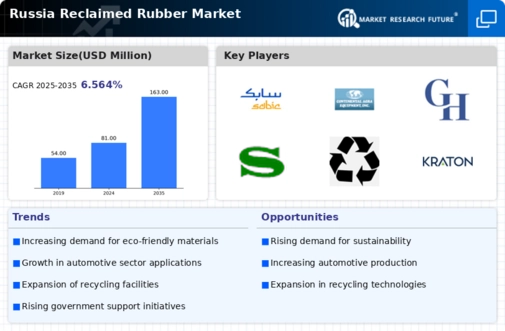The Russia Reclaimed Rubber Market is characterized by a dynamic competitive landscape driven by a mix of domestic and international players. The market benefits from an industrial base that emphasizes sustainability and recycling, which is particularly significant in the context of growing environmental awareness and regulatory pressures. As a result, reclaimed rubber is increasingly being recognized as a valuable alternative to virgin rubber, offering economic advantages while addressing ecological concerns.
The competitive insights into this market reveal how companies are positioning themselves to leverage trends in eco-friendliness and cost-effectiveness. As these factors continue to shape the market, companies are focused not only on expanding their production capabilities but also on enhancing their supply chain efficiencies and meeting customer demands for higher-quality products and services.
SABIC holds a prominent position in the Russia Reclaimed Rubber Market, focusing on innovative practices and sustainability initiatives. The company's strengths lie in its advanced technology and extensive experience in polymer manufacturing, which allows it to produce high-quality reclaimed rubber solutions tailored to meet the specific needs of the Russian market. SABIC's commitment to sustainability is reflected in its dedication to developing products that reduce environmental impact while offering performance benefits. The market presence of SABIC is bolstered by its strong relationships with local distributors and customers, providing a stable foundation for growth and brand loyalty.
The company's ability to adapt its offerings to align with regional market trends and consumer preferences further enhances its competitiveness and strengthens its footprint in Russia.
Continental AG also plays a vital role in the Russia Reclaimed Rubber Market, emphasizing its expertise in tire manufacturing and related rubber products. The company is known for producing a wide range of high-performance products using reclaimed rubber, which helps reduce waste and promotes circular economy principles. Continental AG maintains a robust market presence supported by its strong research and development capabilities, ensuring that it stays ahead of competitors by introducing improvements in product efficacy and sustainability.
Key products from Continental AG in the reclaimed rubber segment include innovative tire solutions that deliver exceptional performance while minimizing impact on the environment. Additionally, the company has been active in mergers and acquisitions to bolster its market position, allowing it to integrate new technologies and expand its operational capabilities within Russia. The strength of Continental AG lies in its commitment to quality, sustainability, and continuous improvement, making it a formidable player in the reclaimed rubber space within the Russian market.

















Leave a Comment